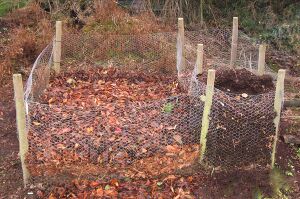Leaf mold

Leaf mold is deciduous leaf compost. It has a dark brown to black color, a pleasant earthy aroma, and a crumbly texture. It is the result of leaves slowly decomposing through fungal breakdown over time. It differs from other types of compost in that it is only made from leaves.
Leaves shed in autumn tend to have a very-low nitrogen content and are often dry. Their main constituents are cellulose and lignin. Because of this, autumn leaves break down slower than other compost ingredients.
Fungal decomposition of a heap of leaves in the open can take between one and two years to break down into a dark brown fine powdery humic matter. During the two to three years that the process takes to complete in damp temperate climates, a succession of different fungal species may be involved. A range of microfauna are also involved in converting the leaf material into a fine-grained humus, including many isopods, millipedes, and earthworms.
In the natural environment the slow decomposition of leaves provides a moist growing medium for young plants and also protects the ground from drying out during periods of low rainfall. It is a significant component of soil organic matter, particularly in temperate deciduous woodland. The slow rate of decomposition allows the plant nutrients bound up in the leaves to be released slowly back into the environment where they can be re-used by plants. Autumn leaves are often collected as part of gardening or farming and kept in pits or containers so that the leaf mold can be used in the garden. The presence of oxygen from the air and sufficient moisture are essential for leaf decomposition. Leaf mold is not high in nutrient content, but it is excellent humic soil conditioner because of its ability to retain moisture and provide a good growing medium for seedling roots.
Leaves collected off roads and pavements may be contaminated by pollutants which can become more concentrated as the leaves decompose into a smaller volume.